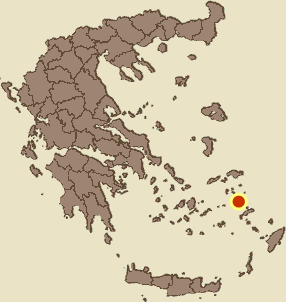Voutsani, Kalymnos, Dodecanese,South Aegean
Kastraki of Kalymnos
| Location: |
| On a rocky hill SW of Voutsani settlement, near the town Vathys of Kalymnos |
| Region > Prefecture: |  |
| South Aegean Dodecanese | |
| Municipality > Town: | |
| City of Kalymnos • Voutsani | |
| Altitude: | |
|
Elevation ≈ 320 m (Relative Height≈120 m) |
| Time of Construction | Origin | |
| Antiquity | ANCIENT |
|
| Castle Type | Condition | |
| Ruined Tower |
In Ruins
|
Ancient pýrgos, most probably used during the Byzantine period located about 625 m south-southwest from the hamlet Voutsani’s church.
Castle Description
Text: Dr. Michael Losse, Singen (Hohentwiel), Germany (05.07.2021)General Description
Kastraki, situated on a spur (about 320 m) overlooks the hamlet Voutsani, which is located roughly 800 m afar form Rina, the eastern-most of the villages in the Vathys valley. The valley, especially the area of Rina next to the port bay, was heavily populated in Byzantine times. This and the fact that the location of the Kastraki offers good views (so to the ancient Pyrgos Filakes at Vathys valley and to Mt. Profitis Ilias at Kalymnos as well as to the Turkish coast) suggest that the fortification was also used in Byzantine times. The presence of Byzantine ceramics around Kastraki also speaks in favour of this. When the tower stood at full height Kastellas and Viglia on Kalymnos also were visible from here.
Archeologist Michail I. Koutellas (2006, p. 55), who named Kastraki as an “Ochyro/Fort” (p. 54), described Kastraki‘s (and the Pyrgos Fylakes‘s) function as follows: “rectangular towers, built with large stone blocks, at locations from which it was possible for guards to oversee the entire Vathys valley, as well as keep watch over the open sea betwenn Kalymnos and Asia minor. In the case of the appearance of enemies they notified the population with fire signals, giving them ample time to take cover in the nearby Empolas Fortress.” Those functions could have been the same for all those three fortifications during the Byzantine period.
Inside the Pyrgos, a rectangular tower (7,8 x 6,95 m) with an enceinte, some remains of undated but younger masonry are visible. It seems the Kastraki was rebuilt in modern times to be used as a farmhouse. Later it was pulled down for the re-use of stones for modern buildings.
History of the castle
On an information board at the Archeological Museum of Kalymnos in the island’s capital Pothia, Kastraki is listed as “early hellenistic”. The Kalymnian Historian and Archeologist Michail I. Koutellas (2006, p. 55) named it amongst the Vathys valley’s “defensive fortifications of the Early Hellenistic Years (late 4th-early 3rd century A. D.)”.
Due to the facts that the area was heavily populated in Byzantine times, that the site of the Kastraki offers good views (cf. above: description) and that one can find Byzantine ceramic sherds next to Kastraki the castle was most probably used in the Byzantine period. In modern times it seems to have been a farmhouse. Later most of the building was pulled down for the re-use of stones for modern buildings.
Other Info
SourcesLosse, Michael: Die Burgen und Befestigungen auf den Dodekanes-Inseln Kálymnos, Télendos und Psérimos. In: Burgenforschung – Europäisches Correspondenzblatt für interdisziplinäre Castellologie 2, 2013, Marburg (Lahn) 2014, pp. 179-216.
| First entry in Kastrologos: | July 2021 |
Sources
- Photos (May 2006) and article by Dr. Michael Losse
|
|
| Access |
|---|
| Approach to the monument: |
| From Voutsani follow a goat path to Kastraki. |
| Entrance: |
| Free access |



